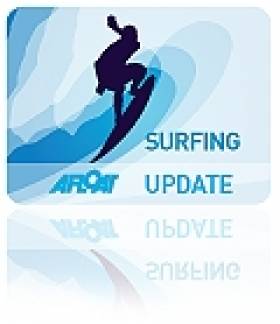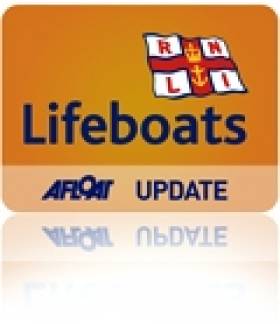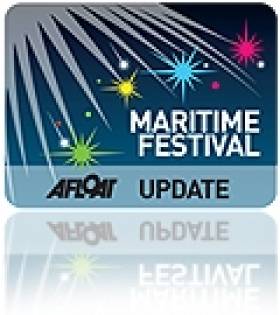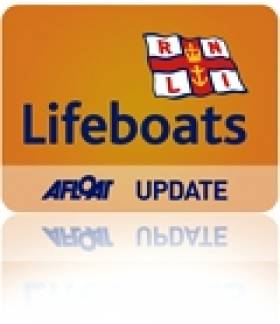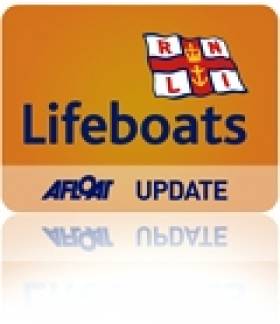Displaying items by tag: Wexford
Wexford Gets On The Surfing Map With First Surf School
#Surfing - Wexford now has its first ever dedicated surf school - thanks to two enterprising brothers.
The Wexford People reports on The Surf Shack in Curracloe, established by Chad and Jack-Tim Murray in an effort to put the Sunny South East on the Irish surfing map.
"Everybody knows that there are good waves on the West Coast," says Jack-Tim, referring to popular surf spots like Lahinch, Mullaghmore and Bundoran, "but most people don't even know that surfing exists on Ireland's east coast, let alone in Wexford."
The brothers aim to entice beginners to the sport, highlighting the smaller surf and safe swimming at Curracloe beach as the perfect environment for novices to ride the waves.
The Wexford People has more on the story HERE.
Busy Times For RNLI At Courtmacsherry And Courtown
#RNLI - Courtmacsherry RNLI assisted two people after their yacht got into difficulty at the weekend.
The volunteer lifeboat crew was called out at 5.15pm on Saturday (13 July) to go to the aid of a yacht off Courtmacsherry Harbour in West Cork.
The all-weather lifeboat with a crew of six was underway within minutes and proceeded to the area where the casualty had developed mechanical failure. The lifeboat arrived on the scene in 10 minutes and proceeded to take the yacht with two people on board in tow.
Both the lifeboat and the stricken vessel were subsequently berthed at the pier in Courtmacsherry village.
This has been a busy week so far for Courtmacsherry RNLI with today's call-out being the fourth in five days.
The others were on Tuesday 9 July to an overdue jet ski in Clonakilty Bay, Thursday 11 July to the aid a windsurfer off Garrettstown, and Friday 12 July to a reported dingy off the Old Head of Kinsale which turned out to be a dead and upturned whale in the sea.
Elsewhere, Saturday was a busy evening for the Courtown lifeboat in Co Wexford.
- lifeboat was launched to a report of two vessels aground in a cove south of Courtown Harbour, quickly locating the vessels – a 15ft speedboat and a personal water craft (PWC) – just south of the harbour in the area known as Salt Rock.
There were two people with the vessels and the speedboat was grounded but swamped.
The lifeboat took both casualties, who were very cold, back to the harbour and then returned first to recover, bail out and tow the speedboat back, and then out to tow the PWC back into the harbour.
The lifeboat then returned to station and refuelled, ready for the Sea Sunday celebrations the following day.
#laser – Ryan Glynn in the Radials with straight firsts was the stand-out performance at last weekend's Laser Leinster Championships in Wexford Harbour Boat Club.
Conditions were 5-15 knots and shifty on Saturday then blowing stink Sunday, all in a fantastic warm, but unstable westerly breeze that reduced racing on Sunday to just one race.
Chris Penney and Mattie O'Dowd had a titanic struggle at the top of the Standard fleet and in the 4.7s, Conor O'Beirne of the Royal St. George YC came through in the last race with a nice confidence boost before he heads off this week to Hungary for the 4.7 European championships.
Results below from Wexford Harbour Boat Club
Laser Leinster Championship Std 2013
Entries: 17 Races Sailed: 4 Discard: 1
| Series Place | Sail No | Type of Boat | Class | Helm | Club | Series Points | Race 1 | Race 2 | Race 3 | Race 4 |
| 1 | 201566 | S | Chris Penney | East Antrim BC | 5 | 3 | 1 | 1 | 3 | |
| 2 | 181999 | S | Mathew o'Dowd | Royal St. George YC | 5 | 1 | 2 | 2 | 2 | |
| 3 | 185104 | S | Conor Simms | Royal Ulster YC | 10 | 2 | 3 | 8 | 5 | |
| 4 | 198554 | S | Conor Byrne | Royal St. George YC | 11 | 6 | 4 | 3 | 4 | |
| 5 | 193562 | S | Oisin McClelland | Ballyholme YC | 19 | 10 | 8 | 11 | 1 | |
| 6 | 197364 | S | Sean Murphy | Kinsale YC | 19 | 8 | 7 | 4 | 10 | |
| 7 | 178335 | S | M | Sean Craig | Royal St. George YC | 20 | 4 | 5 | 12 | 11 |
| 8 | 201365 | S | M | Stephen Penney | East Antrim BC | 20 | 9 | 12 | 5 | 6 |
| 9 | 155068 | S | M | Ross o'Leary | Royal St. George YC | 21 | 5 | 6 | 10 | 14 |
| 10 | 191670 | S | M | Colin Galavan | Royal Irish YC | 24 | 12 | 11 | 6 | 7 |
| 11 | 185043 | S | Peter Cameron | East Antrim BC | 25 | 11 | 10 | 7 | 8 | |
| 12 | 198560 | S | Henry McLaughlin | Carlingford Lough YC | 25 | 7 | 9 | 9 | 9 | |
| 13 | 181674 | S | M | Troy Hopkins | Howth YC | 39 | 13 | 13 | 15 | 13 |
| 14 | 173164 | S | M | Timmy Washington | Wexford Harb. B&TC | 40 | 15 | 14 | 14 | 12 |
| 15 | 178689 | S | M | Tommy Fallon | Wexford Harb. B&TC | 43 | 14 | 16 | 13 | 18 |
| 16 | 180237 | S | M | Paul Ebrill | Wexford Harb. B&TC | 47 | 16 | 15 | 16 | 18 |
| 17 | 137120 | S | Don Ryan | Wexford Harb. B&TC | 54 | 18 | 18 | 18 | 18 |
Laser Leinster Championship Radial 2013
Entries: 32 Races Sailed: 4 Discard: 1
| Series Place | Sail No | Type of Boat | Class | Helm | Club | Tally | Series Points | Race 1 | Race 2 | Race 3 | Race 4 |
| 1 | 198552 | R | Y | Ryan Glynn | Ballyholme YC | 64 | 3 | 1 | 1 | 1 | 1 |
| 2 | 190758 | R | Y | Dougie Power | Waterford Harb. SC | 19 | 13 | 2 | 2 | 13 | 9 |
| 3 | 183948 | R | Y | Ross O'Sullivan | Kinsale YC | 76 | 13 | 14 | 7 | 4 | 2 |
| 4 | 203715 | R | Y | Tim Brow | Ballyholme YC | 72 | 13 | 6 | 4 | 7 | 3 |
| 5 | 181428 | R | Y | Ronan Jones | Wexford Harb. B&TC | 74 | 17 | 9 | 6 | 2 | 33 |
| 6 | 200637 | R | Y | Ruairi Finnegan | Waterford Harb. SC | 85 | 17 | 8 | 3 | 33 | 6 |
| 7 | 191247 | R | Y | Andrew Penney | East Antrim BC | 45 | 19 | 5 | 5 | 9 | 14 |
| 8 | 198780 | R | Y | Tadhg o'Loingsigh | Tralee Bay SC | 87 | 21 | 10 | 8 | 3 | 33 |
| 9 | 201603 | R | Y | Conor o'Farrell | Carlingford Lough YC | 63 | 21 | 12 | 9 | 8 | 4 |
| 10 | 190755 | R | John Flynn | Dungarvan Harb. SC | 12 | 27 | 3 | 12 | 12 | 12 | |
| 11 | 199054 | R | Y | Gary Fekkes | East Antrim BC | 93 | 27 | 7 | 14 | 10 | 10 |
| 12 | 187591 | R | Y | Kevin Harrington | Courtown SC | 99 | 28 | 18 | 17 | 6 | 5 |
| 13 | 197362 | R | YL | Erica Ruigrok | Rush SC | 75 | 29 | 4 | 10 | 15 | 18 |
| 14 | 198556 | R | Y | Mark Bolger | Royal St. George YC | 53 | 31 | 11 | 15 | 5 | 15 |
| 15 | 190759 | R | Y | Conor Murphy | Kinsale YC | 6 | 31 | 15 | 13 | 11 | 7 |
| 16 | 196533 | R | Y | Sam Wilkinson | Ballyholme YC | 91 | 32 | 13 | 11 | 17 | 8 |
| 17 | 175356 | R | Y | Patrick Cahill | Royal St. George YC | 55 | 43 | 16 | 22 | 16 | 11 |
| 18 | 190774 | R | YL | Aoife Hopkins | Howth YC | 54 | 46 | 21 | 19 | 14 | 13 |
| 19 | 192602 | R | YL | Suzanne Flannigan | Ballyholme YC | 78 | 52 | 33 | 18 | 18 | 16 |
| 20 | 192333 | R | Y | Daire Cournane | Kinsale YC | 8 | 55 | 25 | 16 | 20 | 19 |
| 21 | 201828 | R | Y | Luke Murphy | Royal St. George YC | 2 | 59 | 17 | 23 | 19 | 33 |
| 22 | 178328 | R | Y | Thomas McGrath | Royal Cork YC | 100 | 62 | 19 | 21 | 22 | 33 |
| 23 | 200745 | R | Y | Scott O'Sulivan | Kinsale YC | 52 | 65 | 24 | 20 | 33 | 21 |
| 24 | 191319 | R | YL | Sorcha Donnelly | Ballyholme YC | 47 | 65 | 22 | 24 | 23 | 20 |
| 25 | 201678 | R | L | Jessica Rutherford | Hollywood YC | 90 | 67 | 20 | 26 | 21 | 33 |
| 26 | 197894 | R | Y | Nathaniel Gillett | Royal St. George YC | 98 | 69 | 33 | 28 | 24 | 17 |
| 27 | 198526 | R | Y | Charlie Edgar | Donaghadee SC | 79 | 73 | 23 | 25 | 25 | 33 |
| 28 | 143122 | R | Y | Dermot Wildes | Courtown SC | 69 | 86 | 26 | 27 | 33 | 33 |
| 29 | 186795 | R | Y | Gregory Fay | Dungarvan Harb. SC | 43 | 86 | 28 | 31 | 27 | 33 |
| 30 | 167852 | R | Y | Conor Clery | Greystones SC | 71 | 86 | 27 | 30 | 29 | 33 |
| 31 | 196018 | R | Y | Colm Moloney | Courtown SC | 66 | 87 | 29 | 32 | 26 | 33 |
| 32 | 96255 | R | Y | Aaron Jones | Greystones SC | 73 | 87 | 30 | 29 | 28 | 33 |
Laser Leinster Championship 4.7 2013
Entries: 16 Races Sailed: 4 Discard: 1
| Series Place | Sail No | Type of Boat | Class | Helm | Club | Tally | Series Points | Race 1 | Race 2 | Race 3 | Race 4 |
| 1 | 183231 | 4 | Y | Conor O'Beirne | Royal St George YC | 4 | 5 | 3 | 1 | 4 | 1 |
| 2 | 198435 | 4 | YL | Cliodhna o'Regan | Kinsale YC | 86 | 6 | 2 | 2 | 2 | 4 |
| 3 | 180938 | 4 | Y | Richard Thompson | Royal Cork YC | 70 | 7 | 10 | 4 | 1 | 2 |
| 4 | 179328 | 4 | Y | J.D. Elmes | Royal Cork YC | 14 | 12 | 4 | 5 | 3 | 7 |
| 5 | 203716 | 4 | Y | Ciaran Finnegan | Waterford Harb. SC | 88 | 14 | 1 | 10 | 12 | 3 |
| 6 | 201557 | 4 | YL | Jocelyn Hill | County Antrim YC | 84 | 17 | 6 | 3 | 9 | 8 |
| 7 | 190754 | 4 | Y | Conor Sherriff | Courtown SC | 94 | 17 | 5 | 7 | 5 | 17 |
| 8 | 19736 | 4 | Y | Richard Hogan | Howth YC | 38 | 19 | 7 | 9 | 6 | 6 |
| 9 | 189372 | 4 | Y | Billy Duane | Royal Cork YC | 59 | 22 | 9 | 6 | 7 | 10 |
| 10 | 172360 | 4 | YL | Eva Donworth | Royal Cork YC | 77 | 27 | 11 | 11 | 11 | 5 |
| 11 | 172172 | 4 | L | Rebekah Rutherford | Hollywood YC | 92 | 31 | 13 | 8 | 10 | 17 |
| 12 | 198783 | 4 | YL | Caoimhe Cotter | Wexford Harb. B&TC | 57 | 31 | 14 | 12 | 8 | 11 |
| 13 | 163142 | 4 | Y | Luke McGrath | Royal Cork YC | 61 | 34 | 8 | 13 | 13 | 17 |
| 14 | 188461 | 4 | YL | Blathnaid o'Connell | Royal St George YC | 62 | 38 | 12 | 14 | 14 | 12 |
| 15 | 177879 | 4 | Y | Robert Wynne | Dungarvan Harb. SC | 83 | 43 | 17 | 17 | 17 | 9 |
| 16 | 190672 | 4 | YL | Kate MacAdorey | Carlingford Lough YC | 89 | 45 | 15 | 15 | 15 | 17 |
#RNLI - The volunteer lifeboat crew at Kilmore Quay RNLI in Co Wexford had a busy time last week with five call-outs in seven days.
In the first incident on Monday 13 May, a French 6.5m yacht with two people on board got into difficulty as it was taking part in a 'mini Fastnet' yacht race.
The vessel’s crew decided to make for Kilmore Quay due to adverse weather. The yacht had no engine due to race rules and so the lifeboat was reqested to help the crew safely get into the harbour.
The second call-out came last Wednesday evening (15 May) when a member of the public reported to Dublin Coast Guard that a yacht was close in shore and flashing a light.
As the lifeboat crew were letting go the ropes, the coastguard made contact with the vessel, which was at anchor and did not require any assistance.
On Friday afternoon 17 May, the volunteer crew was alerted when an 8m pleasure craft with two people on board had fouled its propeller a quarter mile off the South Head of the Great Saltee Island.
The vessel was freed by the lifeboat crew using a grapnel hook and cutting the rope before towing the boat back to Kilmore Quay Marina.
And last Sunday 19 May saw two shouts which were similar in nature.
The first in the morning involved a small leisure craft with four people on board which suffered engine failure. The crew was relying on a mobile phone for their communications and combined with poor English, it made the task of finding them more challenging.
The crew members were eventually located to the west of the Saltees and were brought back ashore safe and well.
Later the same day, another small leisure craft - this time with three people aboard and again relying on a mobile phone for their communications - had lost power while fishing at the south side of the Little Saltee Island.
The lifeboat was on scene a short time later and towed the vessel back to Kilmore Quay.
Stormy Stan Sails In For Arklow's Gathering of the Fleet
#MaritimeFestivals - Stormy Stan sailed into Arklow aboard tall ship Ruth recently as part of the build up to Arklow RNLI’s Gathering of the Fleet Maritime Festival.
This August Bank Holiday weekend, Arklow RNLI and Arklow Harbour will play host to vessels of all shapes and sizes from tall ships such as Ruth to Naval Service vessels, vintage and prototype RNLI lifeboats, emergency service vessels and visiting boats from all around the UK, Ireland and further afield for the fundraising festival, which is now over 50 years old and continues to go from strength to strength.
Boat trips, kayaking and windsurfing opportunities will be up for grabs, as well as the special attraction of the Thundercat Experience, where visitors can head out on the water aboard a Thundercat racing boat.
There will be aerial attractions too, with a flying visit by the Garda Air Support Unit and the regular Air Sea Rescue Display with the Irish Coast Guard's Rescue 117 helicopter.
And that's not to mention the activities or landlubbers such as the carnival, food and craft stalls, live music, model boats, emergency service demonstrations and vintage vehicles.
Arklow RNLI volunteer lifeboat press officer Mark Corcoran said: "This weekend really is a must for maritime enthusiasts and all the family. Almost all of the events are free. This is our opportunity to put something back in our town.
"Without our communities continued support we couldn’t continue, so make sure to come down to Arklow this August Bank Holiday weekend for the Gathering of the Fleet-Arklow Maritime Festival."
He added: "There really is something for everybody, so put it in the calendar."
Full details of the festival will be available on the festival's Facebook page, where anyone with a vessel who wants to take part in the festival can make contact. There is also an opportunity for any novice or experienced sailors to arrive at the festival aboard a tall ship – e-mail [email protected] for further details.
Arthurstown Pier Pontoon. Boat Berths in County Wexford
Arthurstown Pier is at Waterford Harbour’s eastern shore, seven miles north of Hook Head lighthouse. It is directly east of Passage East. The small quay has a stone bottom. In 2010, following the provision of €56,250 to improve boat access on piers along the Hook Peninsula such as Ballyhack, Slade and Arthurstown Wexford County Council installed a small pontoon facility to encourage leisure boating in the area. As well as local boaters the faciility is also proving popular with local fishermen.
Duncannon Pier Pontoon. Berths for Boats in County Wexford
Duncannon Pier Pontoon is at Waterford Harbour’s eastern shore, six miles north of Hook Head lighthouse. It is a small fishing port where you may come alongside the commercial wall. In 2010, following the provision of €56,250 to improve boat access on piers along the Hook Peninsula such as Ballyhack, Slade and Arthurstown Wexford County Council installed a small pontoon facility to encourage leisure boating in the area. As well as local boaters the faciility is also proving popular with local fishermen.
Station To Station Challenge Raises More Than €2,000 For RNLI
#RNLI - Two men who embarked on the first RNLI Station to Station challenge between Bundoran and Arranmore last Saturday (6 April) completed the job in just under 12 hours - raising over €2,000 for both lifeboat stations in the process.
As per their plan reported previously on Afloat.ie, Niall Clancy and James McIntyre both set off from Bundoran Lifeboat Station just after 6am on Saturday morning – Clancy running and McIntyre cycling.
Clancy's route took him through Bundoran, Ballyshannon, Donegal town, Mountcharles, Frosses, Glenties, Gweebarra Bridge, Lettermacaward, Dungloe, Burtonport and finally Arranmore Island via a treadmill on the ferry!
He was joined on various legs of the journey by members of the Tir Chonaill Athletic Club who kept his spirits up on the 100km journey from station to station.
Meanwhile, McIntyre and his team from Mullaghmore Triathlon Club and Donegal Bay Cycling Club took off at the same time cycling as far as Lough Eske, where James then made the lonesome journey himself across the Bluestack Mountains, constantly keeping organisers informed of his progress via text message.
Down into Glenties and from there by bike to Portnoo where, with Bundoran RNLI crewman Killian O’Kelly, he kayaked the remaining 22km to Arranmore Island, where both he and Clancy were greeted by the lifeboat crew and the Arranmore Pipe Band.
Speaking on completion of the challenge at Arranmore RNLI Lifeboat Station, Clancy said: "It’s been a long but great day. The weather conditions couldn’t have been any better for both myself and James – though it was very cold this morning leaving Bundoran!
"I’m looking forward to a few weeks off training before I get back into it for the Athlone Half Ironman in August."
McIntyre added: "We’d both like to express our gratitude to everyone who supported us ahead of the challenge and today – particularly those who sponsored us and those who ran and cycled with us today, our support teams, our chefs, the RNLI crews and sponsors Ormston’s Mace Ballyshannon and All Sports Donegal Town."
Shane Smith, volunteer lifeboat press officer for Bundoran RNLI, said: "We are thrilled at the success of the challenge and delighted that over €2,000 has been raised for both stations.
"We are indebted to James and Niall for their selfless support of our charity and would like to thank them sincerely on behalf of both crews."
Elsewhere, a Wexford family who organised a sponsored swim in memory of a loved one and former volunteer have raised a whopping €5,000 for Kilmore Quay RNLI.
The Hayes family presented the cheque to the RNLI at Kilmore Quay lifeboat station recently, funded by a sponsored swim on St Stephen’s Day organised by the family in memory of the late Paddy Hayes, who was a volunteer with the lifeboat.
Lifeboat Roundup: Windsurfers Rescued In Waterford; Boats Aground in Wexford, Lough Erne
#RNLI - The Dunmore East RNLI lifeboat was tasked yesterday (7 April) to assist two windsurfers in difficulty near Duncannon in Waterford Harbour.
In rough conditions yesterday afternoon, with south-east winds force 6/7 blowing, coxswain Pauly Daniels reached the casualties' position within 30 minutes.
By this stage one of the surfers had made it ashore safely at Duncannon. The Dunmore East lifeboat quickly located the other windsurfer a quarter of a mile north of Duncannon. The casualty was safely recovered from the water and landed ashore nearby.
Neither casualty was injured and did not need medical attention.
Nearby in Wexford, five teenagers were rescued from a small speedboat after it suffered engine failure and ran aground on the River Slaney around 1.20pm yesterday.
According to Lorraine Galvin, volunteer press officer at Wexford RNLI, the teens' "fast call for help to the coastguard greatly helped in ensuring their speedy rescue in cold, rough weather conditions".
At the time of the rescue there were wind speeds of force 5 south-easterly and a rough sea state. All of the passengers were starting to suffer from the cold and were treated for mild hypothermia.
Meanwhile, on Upper Lough Erne last Friday the volunteer lifeboat at Enniskillen RNLI (Carrybridge) launched to reports of a vessel that had run aground.
The RNLI lifeboat and rescue water craft were both launched and proceeded to the casualty's last known location 2.5 miles upstream from Carrybridge at Innishmore viaduct.
On route to the scene at the Innishmore viaduct, the volunteer crew got further information that the vessel had managed to refloat and was currently at Killygowan Island.
A full inspection was carried out and none of the crew on the casualty vessel were found to be in need of medical attention.
It was decided with the owner's permission that the volunteer crew would escort their vessel back to Carrybridge with the lifeboat leading and rescue water craft following as the navigation lights were not working.
Wexford Prepares for Second John Barry Maritime Festival
#maritimefestival – The organisers of the John Barry Maritime Festival are expecting crowds of over 50,000 to visit Wexford in June. The second John Barry Maritime Festival, which is one of three Gathering flagship events, takes place this year from Thursday 20th until Sunday 23rd June in Wexford and promises to be bigger and better than the inaugural festival in 2012, which saw crowds of 35000 over the two day event.
The idea originated in January last year after a lifeboat visit to the Waterford Coast Guard Helicopter base. The three RNLI volunteers David Maguire, Frank O Brien and Lorraine Galvin were discussing plans to celebrate Wexford Lifeboat Station 10 year anniversary. "..ideas for fun on the quay developed into an idea for a maritime festival" says Lorraine, " with maritime activities, races, childrens activities, live music and entertainment, exhibitions, cultural events and the hugely successful Wexford food familys food village". It was wonderful to see so many children on the quay enjoying kayaking and boating, arts and crafts, science experiments, the funfair and my own little toddler dancing away at the Kindermusik sessions".
As well as family fun, the festival also celebrates Wexford man Commodore John Barry, father of the US Navy. In September last year the festival directors invited over two US Navy Rear Admirals to Wexford and discussed plans for this years festival and forming links with the US Navy. "...The Rear Admirals had great admiration for John Barry and were very interested in learning more of his heritage and home town told by historian Bernard Brown" said Frank O Brien.
David Maguire saif that the festival success was down to great community support and invovlement.." Wexford has such a great maritime heritage and we want to show it off, we are working with great local groups and the best of Wexford food producers, it will be a real Wexford showcase".
The three have been busy already securing the festival as a flagship gathering event and are actively inviting international visitors to Wexford for the festival. "There are so many wonderful events in the planning, Wexford Quay is such an amazing amphitheatre for a festival and what better view than Wexford Harbour!" The festival is non profit organisation with fundraising proceeds towards Wexford RNLI Lifeboat. Any interested groups are invited to contact the team at [email protected] or through the website www.jbmf.ie


























